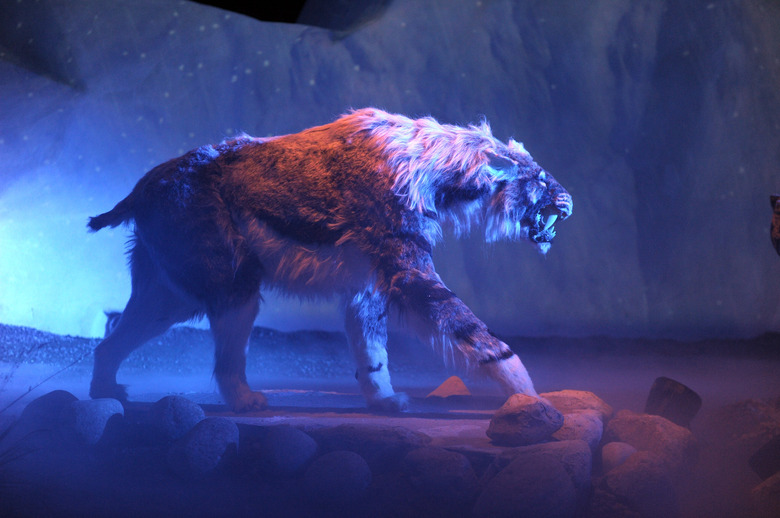Why Did The Saber Tooth Tiger Go Extinct?
The saber-tooth tiger is remembered with wonder as a relic of the last ice age, but the truth is both more interesting and more mundane. Despite its size, weighing in at around five feet long and 440 lbs, and its two, seven-inch canine teeth, environmental change, lack of food, and human hunting saw this fascinating beast die off from the face of the Earth.
The Smilodon (the proper name for the species) is part of the Falidae family that includes all cats, both living and extinct. It lived in North and South America and is commonly depicted as having lived side by side with humanity during the last ice age. In truth, the species is actually much older than that; fossil evidence dates it to around 1.8 million years ago. A similar but smaller species, Smilodon gracilis, lived 2.5 million years ago. Scientists have uncovered enough facts about the species formulate some ideas about how it passed from the world 10,000 years ago, but each theory has its challengers.
TL;DR (Too Long; Didn't Read)
Scientists theorize that environmental change, decline in prey population, and human activity lead to the death of the saber-tooth tiger some 10,000 years ago.
The Begining of The End
The Begining of The End
The Smilodon went extinct around the end of the last glacial period in what was known as the Quaternary extinction event. Fifteen kinds of large mammals went extinct in North America during that 1,500-year window. To put this in perspective: only 33 total went extinct during the past 50,000 years. The saber-tooth had survived previous glacial periods, but this extinction event included changes in temperature and, in turn, vegetation, which directly affected the smilodon's prey. The event created large consequences throughout the local food chain, which could have ultimately killed off the big cats.
A Change in The Weather
A Change in The Weather
Glaciers began receding across continents around the time of the Quaternary extinction event. Seasons changed, and precipitation changes could have altered the condition of local ecosystems. Over a 5,000 year period, the temperature rose more than six degrees, which, some scientists speculate, had big consequences for larger animals. If climate change did lead to the Smilodon extinction, then something specific must have occurred that was not present in previous glacial periods. A more esoteric hypothesis is that diseases led to these mass extinctions, but there is little proof of that.
Food Supplies Dried Up
Food Supplies Dried Up
The diet of the Smilodon included bison, deer, and ground sloths, many of which either went extinct or began experiencing population drops around the same time the as the sabre-tooth, leading some to believe this lead to the latter specie's demise. Bison numbers dropped dramatically as grasslands transformed into forests, suggesting environmental factors constrained bison populations. When humans eventually reached North America, they represented further competition, vying with the Smilodon over dwindling sources of food.
Hunters Become The Hunted
Hunters Become The Hunted
The extinction of the saber-tooth tiger also happens to align with the period when humans started to make huge strides in hunting technology. This was around the time of the Clovis tribes, a group of early humans known for their simple projectile weapons. Humans would not have hunted the saber-tooth tiger for food, but may have killed them for protection or sport. Some researchers refute this hypothesis, asserting that humans did not have the means or the desire to drive other animals to extinction at the time.
References
- American Museum of Natura History: What is the Climate Change Hypothesis?
- American Museum of Natura History: What is the Overkill Hypothesis?
- Oxford Martin School:African lions face the same threats as extinct sabre-toothed tigers
- PLOS ONE: Implications of Diet for the Extinction of Saber-Toothed Cats and American Lions
- National Center for Biotechnology Information: Global late Quaternary megafauna extinctions linked to humans, not climate change
Cite This Article
MLA
Stutsman, Jacob. "Why Did The Saber Tooth Tiger Go Extinct?" sciencing.com, https://www.sciencing.com/did-tooth-tiger-go-extinct-6113344/. 19 April 2018.
APA
Stutsman, Jacob. (2018, April 19). Why Did The Saber Tooth Tiger Go Extinct?. sciencing.com. Retrieved from https://www.sciencing.com/did-tooth-tiger-go-extinct-6113344/
Chicago
Stutsman, Jacob. Why Did The Saber Tooth Tiger Go Extinct? last modified August 30, 2022. https://www.sciencing.com/did-tooth-tiger-go-extinct-6113344/
